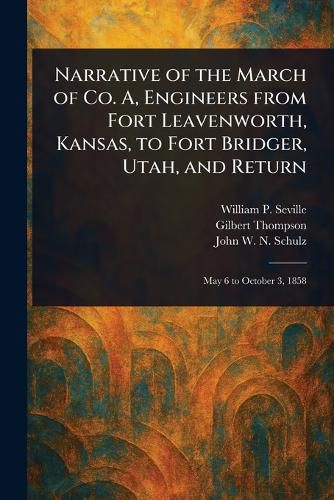Readings Newsletter
Become a Readings Member to make your shopping experience even easier.
Sign in or sign up for free!
You’re not far away from qualifying for FREE standard shipping within Australia
You’ve qualified for FREE standard shipping within Australia
The cart is loading…






This title is printed to order. This book may have been self-published. If so, we cannot guarantee the quality of the content. In the main most books will have gone through the editing process however some may not. We therefore suggest that you be aware of this before ordering this book. If in doubt check either the author or publisher’s details as we are unable to accept any returns unless they are faulty. Please contact us if you have any questions.
"Narrative of the March of Co. A, Engineers" offers a firsthand account of a pivotal journey in American military history. Penned by William P. Seville, this detailed narrative chronicles the Corps of Engineers' expedition from Fort Leavenworth, Kansas, to Fort Bridger, Utah, in 1858.
Spanning May to October, this meticulously prepared print republication recounts the daily experiences, challenges, and observations of Company A as they traverse the American West. Readers gain insight into the logistical complexities of a military expedition in the 19th century and the vital role the Corps of Engineers played in shaping the landscape and military presence of the United States.
A valuable resource for those interested in military history, the American West, and the history of the U.S. Army, this narrative provides a unique glimpse into a formative period in American expansion and westward development.
This work has been selected by scholars as being culturally important, and is part of the knowledge base of civilization as we know it.
This work is in the public domain in the United States of America, and possibly other nations. Within the United States, you may freely copy and distribute this work, as no entity (individual or corporate) has a copyright on the body of the work.
Scholars believe, and we concur, that this work is important enough to be preserved, reproduced, and made generally available to the public. We appreciate your support of the preservation process, and thank you for being an important part of keeping this knowledge alive and relevant.
$9.00 standard shipping within Australia
FREE standard shipping within Australia for orders over $100.00
Express & International shipping calculated at checkout
This title is printed to order. This book may have been self-published. If so, we cannot guarantee the quality of the content. In the main most books will have gone through the editing process however some may not. We therefore suggest that you be aware of this before ordering this book. If in doubt check either the author or publisher’s details as we are unable to accept any returns unless they are faulty. Please contact us if you have any questions.
"Narrative of the March of Co. A, Engineers" offers a firsthand account of a pivotal journey in American military history. Penned by William P. Seville, this detailed narrative chronicles the Corps of Engineers' expedition from Fort Leavenworth, Kansas, to Fort Bridger, Utah, in 1858.
Spanning May to October, this meticulously prepared print republication recounts the daily experiences, challenges, and observations of Company A as they traverse the American West. Readers gain insight into the logistical complexities of a military expedition in the 19th century and the vital role the Corps of Engineers played in shaping the landscape and military presence of the United States.
A valuable resource for those interested in military history, the American West, and the history of the U.S. Army, this narrative provides a unique glimpse into a formative period in American expansion and westward development.
This work has been selected by scholars as being culturally important, and is part of the knowledge base of civilization as we know it.
This work is in the public domain in the United States of America, and possibly other nations. Within the United States, you may freely copy and distribute this work, as no entity (individual or corporate) has a copyright on the body of the work.
Scholars believe, and we concur, that this work is important enough to be preserved, reproduced, and made generally available to the public. We appreciate your support of the preservation process, and thank you for being an important part of keeping this knowledge alive and relevant.